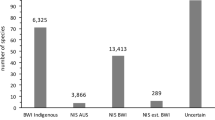Ballast water discharged from vessels harbours a cocktail of potential pathogens.
Abstract
Commercial ships have spread many species around the world1,2,3, but little is known of the extent and potential significance of ship-mediated transfer of microorganisms3,4. Here we show that the global movement of ballast water by ships creates a long-distance dispersal mechanism for human pathogens and may be important in the worldwide distribution of microorganisms, as well as for the epidemiology of waterborne diseases affecting plants and animals.
This is a preview of subscription content, access via your institution
Access options
Subscribe to this journal
Receive 51 print issues and online access
$199.00 per year
only $3.90 per issue
Buy this article
- Purchase on Springer Link
- Instant access to full article PDF
Prices may be subject to local taxes which are calculated during checkout

PAUL SOUDERS/TONY STONE

Similar content being viewed by others
References
Carlton, J. T. Oceanogr. Mar. Biol. Annu. Rev. 23, 313– 374 (1985).
Carlton, J. T. & Geller, J. B. Science 261, 78–82 (1993).
Ruiz, G. M., Fofonoff, P. W., Carlton, J. T., Wonham, M. J. & Hines, A. H. Annu. Rev. Ecol. Syst. (in the press).
Galil, B. S. & Hülsmann, N. Eur. J. Protistol. 33, 244–253 (1997).
Carlton, J. T., Reid, D. & van Leeuwen, H. The Role of Shipping in the Introduction of Nonindigenous Aquatic Organisms to the Coastal Waters of the United States (other than the Great Lakes) and an Analysis of Control Options (Tech. Rep. No. CG-D11-95, US Coast Guard, Washington DC, 1995).
Grimes, D. J. Estuaries 14, 345–360 ( 1991).
Hallegraeff, G. M. Mar. Ecol. Prog. Ser. 168, 297–309 (1998).
McCarthy, S. A. & Khambaty, F. M. Appl. Environ. Microbiol. 60, 2597–2601 (1994).
Colwell, R. R. Science 274, 2025–2031 ( 1996).
Colwell, R. R. & Huq, A. in Vibrio cholerae and Cholera: Molecular to Global Perspectives (eds Wachsmuth, I., Blake, P. & Olsvik, Ø.) 117–134 (Am. Soc. Microbiology, Washington DC, 1994).
Williamson, M. Biological Invasions (Chapman & Hall, London, 1996 ).
Brock, T. D., Madigan, M. T., Martinko, J. M. & Parker, J. Biology of Microorganisms 7th edn (Prentice Hall, Englewood Cliffs, NJ, 1993).
Harvell, C. D. et al. Science 285, 1505– 1510 (1999).
Daszak, P., Cunningham, A. A. & Hyatt, A. D. Science 287, 443– 449 (2000).
Author information
Authors and Affiliations
Corresponding author
Rights and permissions
About this article
Cite this article
Ruiz, G., Rawlings, T., Dobbs, F. et al. Global spread of microorganisms by ships. Nature 408, 49–50 (2000). https://doi.org/10.1038/35040695
Issue Date:
DOI: https://doi.org/10.1038/35040695
This article is cited by
-
Metagenome sequencing and 103 microbial genomes from ballast water and sediments
Scientific Data (2023)
-
Transmission of stony coral tissue loss disease (SCTLD) in simulated ballast water confirms the potential for ship-born spread
Scientific Reports (2022)
-
European primary datasets of alien bacteria and viruses
Scientific Data (2022)
-
Identifying high-risk areas for introduction of new alien species: the case of the invasive round goby, a door-knocker for Norway
Hydrobiologia (2022)
-
Electrokinetic detection and separation of living algae in a microfluidic chip: implication for ship’s ballast water analysis
Environmental Science and Pollution Research (2021)
Comments
By submitting a comment you agree to abide by our Terms and Community Guidelines. If you find something abusive or that does not comply with our terms or guidelines please flag it as inappropriate.



